Dogs are scavengers by nature and may eat anything they come across.
They have no idea, nor can you explain to them that eating something they find on the ground may be dangerous.
Chewing rocks can damage your dog's teeth and cut the inside of her mouth. Swallowing stones may create an intestinal blockage, lead to vomiting and diarrhoea, or cause your dog to choke. Some veterinarians think a dog who has swallowed and not eliminated rocks over a period of time has a 50/50 chance of survival.
- Dogs are scavengers by nature and may eat anything they come across.
- Some veterinarians think a dog who has swallowed and not eliminated rocks over a period of time has a 50/50 chance of survival.
Eating rocks can be fatal!
Many people whose dogs eat rocks have successfully altered or stopped this behaviour by using the methods suggested in this article. With patience, luck and determination, you will find the best way to stop your dog from eating stones.
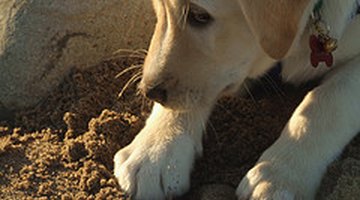
It's natural for puppies and dogs to use their mouths to explore their surroundings.
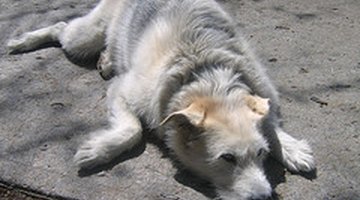
A dog who eats stones may be acting out of boredom, anxiety or frustration.
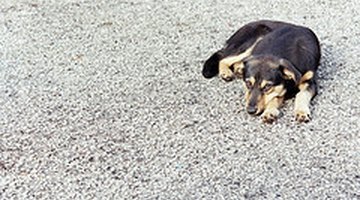
Your dog may be ill, in pain, in need of exercise or lonely. She may have a condition called pica, which causes people or animals to compulsively eat nonfood items.
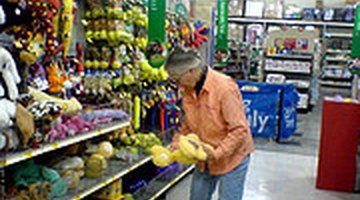
Gather a variety of tempting chew toys and rotate them every few days so they always appear to be "new" to your dog. You don't have to buy expensive new toys. Thrift stores often have toys and balls dogs can play with, but check carefully to make sure there is nothing that can choke your dog.
- It's natural for puppies and dogs to use their mouths to explore their surroundings.
- Thrift stores often have toys and balls dogs can play with, but check carefully to make sure there is nothing that can choke your dog.

For some dogs, attention, exercise and training may help curb the habit. Try diversionary tactics such as providing toys that are made specifically for dogs who need and love to chew.
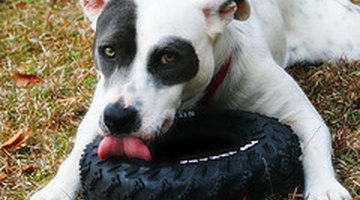
Unfortunately, diversion won't work with dogs who fixate on specific items; the only solution in these cases is to remove the objects so the dog has no access to them.
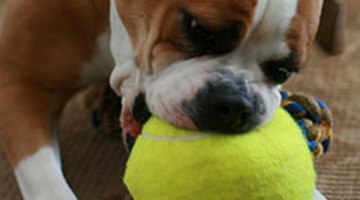
Teach your dog the command "Leave it!" After you give the command, you must make sure your dog does not touch or pick up the item. When she listens and leaves the object alone, it is crucial that you immediately reward her with something she really likes. Practice this over and over again.
- For some dogs, attention, exercise and training may help curb the habit.
- When she listens and leaves the object alone, it is crucial that you immediately reward her with something she really likes.
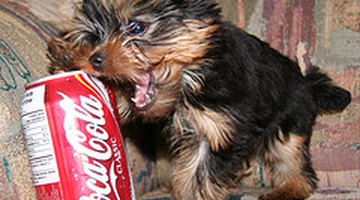
If you catch your dog eating rocks, try startling him by shaking an aluminium can filled with coins or taking aim with a squirt bottle filled with cold water. Do not let your dog see you rattling the can or spraying the water, because you do not want him to associate your presence with the unpleasant noise or water. You want him to associate the negative experience with the rock-eating behaviour. Always praise him when he leaves items alone.
- If you catch your dog eating rocks, try startling him by shaking an aluminium can filled with coins or taking aim with a squirt bottle filled with cold water.
- Do not let your dog see you rattling the can or spraying the water, because you do not want him to associate your presence with the unpleasant noise or water.
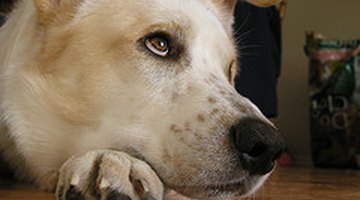
Cover some stones with a layer of bitter apple solution, and put the rocks where your dog is likely to spend time. Most dogs hate the taste of bitter apple, and if you add one sharp "NO!" at the moment your dog notices the bad taste, your dog may eventually associate the bitter flavour with your rebuke.

As soon as your dog drops the stone, give her a treat, preferably something satisfying she can chew on for a while. This process will take some time, so be patient. You are trying to convince your dog that something she really enjoys is no longer enjoyable.
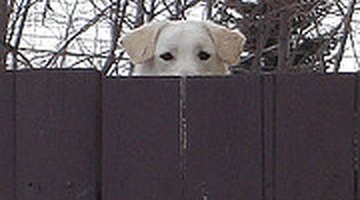
Just as you dog-proof the inside of your house, you can dog-proof your yard. For each danger in the yard, you have to decide whether to remove the object(s), fence off the area where the objects are, create a fenced area in the yard for your dog, or supervise your dog whenever she is in the yard.
- As soon as your dog drops the stone, give her a treat, preferably something satisfying she can chew on for a while.
- For each danger in the yard, you have to decide whether to remove the object(s), fence off the area where the objects are, create a fenced area in the yard for your dog, or supervise your dog whenever she is in the yard.
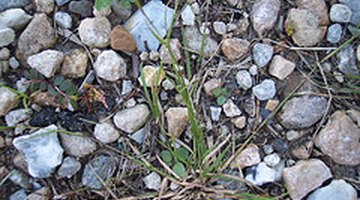
Another way to keep your dog from eating stones is to separate the dog from rocks, stones and coarse gravel. If you can't remove the rocks, then put a barrier or fence around them. This may sound extreme, but dogs who chew on and swallow rocks are at risk for internal damage, blockages requiring major surgery, and in the most serious cases, death.

Yelling or punishment in direct response to stone eating may inadvertently provide the attention your dog is seeking when she eats stones. Some dogs will even stop eating rocks when their owner is nearby, but return to eating them when their owner is away.
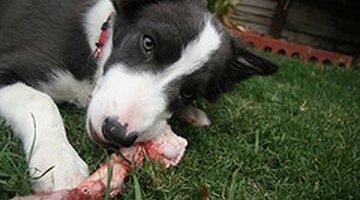
Be very careful about giving dogs bones or food to chew outdoors, with the hope that this will keep their attention away from the inedible items. If a dog lies on the rocks to eat, then, when he is finished eating, the rocks will taste like the delicious bone or treat, and may be the next thing your dog eats.
- Yelling or punishment in direct response to stone eating may inadvertently provide the attention your dog is seeking when she eats stones.
- Be very careful about giving dogs bones or food to chew outdoors, with the hope that this will keep their attention away from the inedible items.
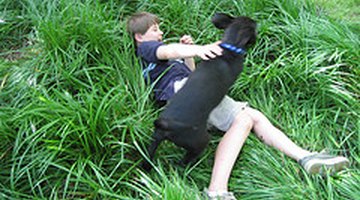
If your dog is left alone most of the day, she is probably bored and lonely. Try spending more time with her, including walks and active play. Providing your dog with exercise, activity and attention may help make her too tired and happy to rely on rock eating for entertainment.
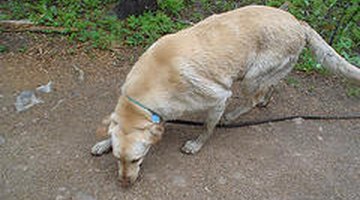
When going for walks, keep your dog leashed to stop her from wandering off and eating non-food items.
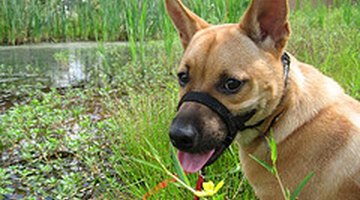
Try using a head halter ((e.g., Gentle Leader or Halti), which will help you keep your dog from scavenging on the ground as you walk.
- When going for walks, keep your dog leashed to stop her from wandering off and eating non-food items.
- Try using a head halter ((e.g., Gentle Leader or Halti), which will help you keep your dog from scavenging on the ground as you walk.

If you go to off-leash areas and allow your dog run loose, try muzzling her first. Doing so will prevent your dog from eating forbidden items when she is exploring. Never leave your dog unsupervised while she's wearing a muzzle.
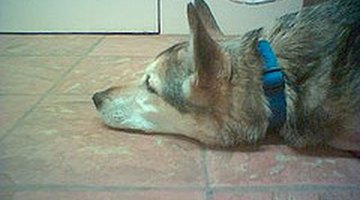
Medical reasons, such as disorders of the intestinal tract, nutrient or enzyme deficiencies, diabetes mellitus, or other illnesses may cause indiscriminate eating behaviour.
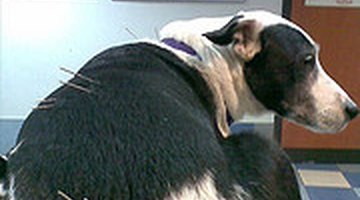
Homeopathy, acupressure, acupuncture and herbs have helped some dogs who suffer from pica, the condition that includes stone eating and the consumption of other inedible objects.
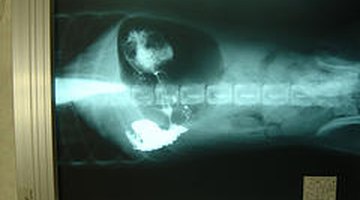
Your dog may attempt to eat small stones when he is suffering from bloat, a painful condition that is a very serious and potentially fatal health risk for dogs.
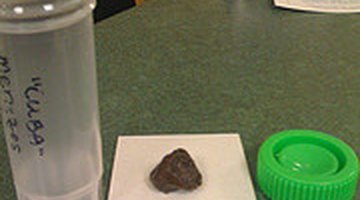
If you do not succeed at changing your dog's habits on your own and your veterinarian finds no underlying illness that could be causing the stone-eating behaviour, your vet may consider diagnosing your dog with obsessive-compulsive disorder, for which antidepressants may be prescribed.
TIP
Stopping this dangerous behaviour can be very difficult, but don't give up. If necessary, find an animal behaviourist to work with you and your dog. Whether you choose prevention or training or a combination of methods, your success could make the difference between life and death for your dog.
WARNING
If you think your dog has swallowed rocks or stones, call your veterinarian.
